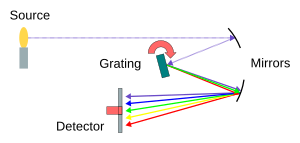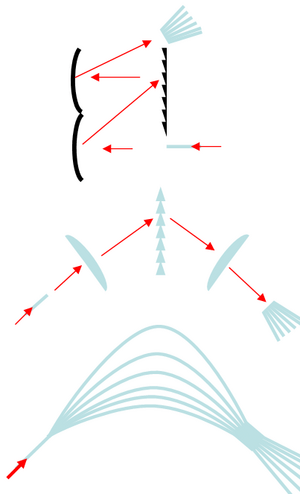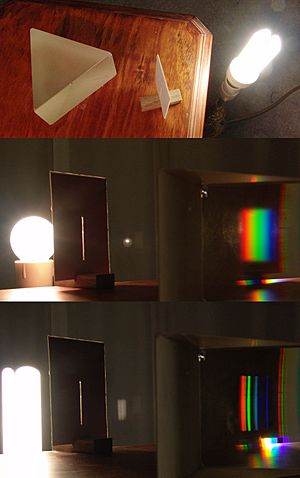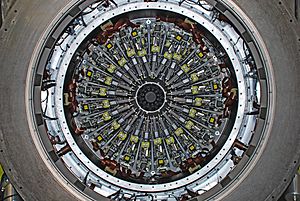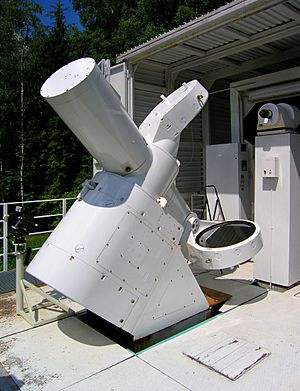Optical spectrometer facts for kids
An optical spectrometer (also called a spectrophotometer, spectrograph, or spectroscope) is a cool tool that helps us measure different things about light. It looks at light over a certain part of the electromagnetic spectrum, which includes all kinds of light, not just what we can see. Scientists often use it in a process called spectroscopic analysis to figure out what materials are made of.
Usually, a spectrometer measures how bright the light is. It also looks at the wavelength of the light, which tells us its color. Sometimes, it measures things related to the energy of the light, like wavenumbers or electron volts.
Spectrometers are used in spectroscopy to create and measure spectral lines. These lines are like unique barcodes for different elements. Spectrometers can work with many types of light, from powerful gamma rays and X-rays to far infrared light. If a spectrometer measures light very precisely, it's often called a spectrophotometer. Most spectrophotometers work with light near what our eyes can see.
Spectrometers are super useful in many areas. For example, astronomers use them to study light from stars and planets. This helps them figure out what these distant objects are made of. The spectrometer uses a prism or a special mirror called a grating to spread light into all its different colors, like a rainbow. This lets astronomers see the unique "fingerprints" of chemical elements. These fingerprints appear as bright lines in the spectrum. If light passes through a gas cloud, it can create dark lines, which also help identify chemicals. A lot of what we know about the universe's chemical makeup comes from studying these light spectra.
Contents
Spectroscopes: Tools for Seeing Light's Secrets
 |
|
| Other names | Spectrograph |
|---|---|
| Related items | Mass spectrograph |
Spectroscopes are often used in astronomy and some parts of chemistry. The first spectroscopes were simple prisms that spread light into a spectrum. They had marks to show the different wavelengths of light. Today's spectroscopes usually have a diffraction grating (a special mirror that spreads light), a movable slit (a narrow opening), and a photodetector (a sensor that detects light). These parts are often controlled by a computer.
A scientist named Joseph von Fraunhofer created the first modern spectroscope. He combined a prism, a slit, and a telescope. This made the spectrum much clearer and allowed other scientists to get the same results. Fraunhofer also invented the first spectroscope that used diffraction. Later, Gustav Robert Kirchhoff and Robert Bunsen found out that spectroscopes could be used to identify chemicals. They even used this method to discover two new elements: caesium and rubidium. Their work also helped explain the dark lines seen in light from stars, called Fraunhofer lines.
When a material gets hot enough to glow (like a light bulb filament), it gives off light that is special to its atomic makeup. Think of it like a unique fingerprint for each element. For example, the element sodium has two very clear yellow lines at specific wavelengths (588.9950 and 589.5924 nanometers). You might recognize this color from low-pressure sodium vapor lamps, which are often used for streetlights.
In the first spectroscope designs from the early 1800s, light would enter through a narrow slit. A special lens would then turn this light into a thin, parallel beam. This beam would then pass through a prism, which would bend the light and spread it into a spectrum. This happens because different colors (wavelengths) of light bend by different amounts. People would then look through a viewing tube that had a scale, allowing them to measure the spectrum directly.
As photographic film was developed, the more accurate spectrograph was invented. It worked on the same idea as the spectroscope but used a camera instead of a viewing tube. More recently, electronic sensors like photomultiplier tubes have replaced cameras. This allows for real-time analysis with much better accuracy. Arrays of photosensors are also used. This kind of spectral analysis, or spectroscopy, has become a very important scientific tool. It helps us figure out what unknown materials are made of, study things happening in space, and test ideas about the universe.
Spectroscopes in Gemology
Gemologists (people who study gemstones) often use spectroscopes. They use them to see how gemstones absorb light. This helps them figure out what kind of gem they are looking at. A gemologist can compare the light absorption pattern they see with a list of patterns for different gems. This helps them identify the exact type of gem.
Spectrographs: Recording Light's Story
A spectrograph is a device that separates light by its different wavelengths and then records this information. It usually has a special detector system or camera that captures and saves the light's spectrum.
The term "spectrograph" was first used in 1876 by Dr. Henry Draper. He invented an early version of this device and used it to take pictures of the spectrum of the star Vega. This first spectrograph was big and hard to use.
There are different kinds of spectrographs, depending on the type of light waves they study. The first spectrographs used photographic paper to record the light. For example, a plant pigment called phytochrome was discovered using a spectrograph that actually used living plants as the detector! More modern spectrographs use electronic detectors, like CCDs. These can be used for both visible light and UV light. The type of detector chosen depends on the wavelengths of light that need to be recorded.
Spectrographs for Stars and the Sun
Spectrographs that used photographic paper helped scientists classify stars by their light. They also helped discover the main sequence of stars, Hubble's law (which describes how the universe is expanding), and the Hubble sequence (which classifies galaxies). The James Webb Space Telescope has two powerful spectrographs: one for near-infrared light (NIRSpec) and one for mid-infrared light (MIRI).
Echelle Spectrograph
An Echelle spectrograph is a special type that uses two diffraction gratings. These gratings are placed close together and rotated 90 degrees from each other. Instead of a slit, it uses a single entrance point. A CCD-chip then records the spectrum. Both gratings have wide spacing, and one is designed to show only the first order of light, while the other shows many higher orders. This creates a very detailed spectrum for the CCD to record.
See also
 In Spanish: Espectrofotómetro para niños
In Spanish: Espectrofotómetro para niños
- Circular dichroism
- Cosmic Origins Spectrograph
- Czerny-Turner monochromator
- Imaging spectrometer
- List of astronomical instruments
- List of light sources
- Long-slit spectroscopy
- Prism spectrometer
- Scanning mobility particle sizer
- Spectrogram
- Spectrometer
- Spectroradiometer
- Spectroscopy
- Virtually imaged phased array


